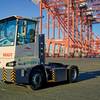Is it a "user fee" or is it a tax?
Senator Hollings (D-SC) has formally proposed to the Conference Committee that a Port Security Infrastructure Improvement Program be included in the Port and Maritime Security legislation that is currently under consideration. This is a 'fleshed-out' and somewhat amended version of his earlier barebones proposal. The Program, if adopted, would impose a fee on shippers of cargoes into or out of the United States in various amounts depending upon what was being shipped. The monies collected would go into a Port Security Trust Fund to pay for various port security expenditures. Similar fees would be imposed on cargoes entering the United States through Canada and Mexico. Sixty percent of the monies would be used to provide financial assistance to port authorities or waterfront facility operators to address identified vulnerabilities. Eighteen percent would be available for competitive grants to address security requirements. Fifteen percent would be available to federal agencies for security activities. It is unclear (at least to this writer) where the remaining 7% goes. Similar to the initial proposal, the fees would be as follows:
Container (non-HAZMAT) $15 per TEU
Container (HAZMAT) $20 per TEU
Passengers $3 per passenger
Vehicles $3 per vehicle
Dry Bulk Cargo $0.01 per metric ton
Crude Oil $0.30 per metric ton
Petroleum Products $0.45 per metric ton
Chemical Products $0.50 per metric ton
Liquid Gases $0.60 per metric ton
Break Bulk Cargo $0.75 per metric ton
Port of Wilmington, Handles Record Volume of Breakbulk Cargo
For the first time ever, the Port of Wilmington, NC, handled more than one million tons of breakbulk cargo in one year for the fiscal year ending June 30, 2002. Cargoes contributing to the record-breaking volume of 1,001,728 tons were export wood pulp and import lumber. Wood pulp, which is exported worldwide from Wilmington for the manufacture of higher grades of paper, exceeded last year's volume by 11%. Lumber, imported from northern Europe and Scandinavia for the home improvement and construction industry, increased tonnage by 77% over last year.
Continuing into the new fiscal year are several terminal improvement projects that will augment Wilmington's customer service capabilities. Most importantly, construction continues for the Wilmington Harbor Deepening project bringing the 42-ft. navigation channel in the Cape Fear River to the Port of Wilmington by November 2003. The relocation of the ocean bar entrance will be completed and new navigation aids installed this fall, while dredging is underway to complete the 42-ft. channel to the State Port, and to add a vessel passing lane. In conjunction with the channel deepening, improvements to handle the new depth at Wilmington's berths are in progress.
Vessel productivity also is being enhanced through a project to extend the 50-ft. gauge container crane rail on the docks. The first phase of the extension has been completed with the remaining portion scheduled to be finished in early fall.
USACE Evaluates Boston Harbor Nav Improvement Project
The U.S. Army Corps of Engineers is conducting a feasibility study and Supplemental Environmental Impact Statement to determine the navigation-related needs of the harbor, port facilities, and harbor users of Boston Harbor. Without deepening portions of the waterways, users will continue to experience tidal related inefficiencies, the port will be unable to accommodate new larger vessels, and cargo will be redirected to other ports. The Corps will conduct a meeting on this issue in South Boston on September 5, 2002.
Tulsa Port of Catoosa Reports Record July
"Shipping tonnage at the Tulsa Port of Catoosa increased in July, making it the best July in 22 years and the second best July in the history of the Port," said Jerry Goodwin, chairman of the City of Tulsa - Rogers County Port Authority. "Shipments of inbound steel, pipe, and dry fertilizer increased along with outbound wheat and liquid fertilizer. Shipments of inbound oats and caustic soda were down slightly along with miscellaneous grains and asphalt," said Goodwin.
Not included in July's tonnage report was the arrival at the Port's low-water wharf of 37 barges carrying more than 800 pieces of military equipment assigned to the Oklahoma National Guard returning from training exercises at Ft. Polk, La. "For the first seven months of the year, the Port's total tonnage is running approximately 2.0 percent ahead of record-setting 1998," said Goodwin. "It's too soon for year-end predictions, but if this momentum continues the Port will certainly have one of its best years ever."
A total of 206,000 tons in 115 barges passed through the Port in July compared to 160,000 tons in 86 barges in June and 189,000 tons in 118 barges last year. Outbound shipments came to 128,000 tons in 64 barges compared to 105,000 tons in 51 barges last month and 102,000 tons in 58 barges last year. Inbound shipments totaled 79,000 tons in 51 barges compared to 54,000 tons in 35 barges in June and 87,000 tons in 60 barges a year ago.
A total of 1.14 million tons of cargo were transported on the McClellan-Kerr Arkansas River Navigation System in July, compared to 929,000 tons in June. In July of last year, 1.05 million tons moved on the system. A total of 18 percent of this July's amount passed over the Tulsa Port of Catoosa docks. The Oklahoma segment of the waterway reported 441,000 tons in July, compared to 369,000 tons in June. Last year, 416,000 tons were recorded. Of June's total, 47 percent went to or from the Tulsa Port of Catoosa.
More than 2 million tons of cargo is shipped through the Port annually in approximately 1,300 barges. Since the Port opened for business in 1971, the facility has served more than 30,000 barges carrying 48 million tons of cargo.
Sponsored Content
Innovative Hull Maintenance: Profitable & Green

Subscribe for
Maritime Reporter E-News
Maritime Reporter E-News is the maritime industry's largest circulation and most authoritative ENews Service, delivered to your Email five times per week












